
Images of the frilled shark, a rarely sighted sea creature that existed 80 million years ago and has changed little since then, made headlines this week after one was caught off the coast of Portugal. But despite this European moment, the shark is more commonly found in Suruga Bay, in Japan. This body of water, the deepest bay in the country, is home to many other jaw-dropping creatures, even if they don't have quite as many teeth.
As this (kind of corny) video posted on National Geographic's website shows, some of Suruga Bay's other residents include a Japanese spider crab, a lantern shark, and a chimaera, which is also sometimes known as a ghost shark.
Japanese spider crab is one of the biggest in the world, according to the Georgia Aquarium. Some people may eat the spider crab; others are eaten by the spider crab. National Geographic's video noted that it's sometimes called the dead man's crab, because it has apparently been known to eat the bodies of people who drowned.
A type of lantern shark also calls the bay home. These sharks can be tiny; they're among the smallest around, and the video notes that one can fit in a palm. According to Smithsonian, the dwarf lantern shark has also been spotted around South America and the Caribbean. The "lantern" part of its name comes from the light it produces from glands on its stomach and fins. These sharks can often be hermaphroditic, according to one study published in 1989.
And, it turns out, the frilled shark is not even the only "prehistoric" shark-like organism found in Suruga Bay. A type of chimaera, which is not a shark but a very distant cousin that took a different evolutionary path from sharks about 400 years ago, according to the WHO, lives there too. Ghost sharks are also found in California, according to the California Academy of Sciences. Rather than a shark, the chimaera is more properly called a cartilaginous fish.

All these creatures live in the bay's quite polluted waters. One study, published in February in Nature Ecology and Evolution and reported on by the Washington Post, looked at chemicals in extremely deep ocean trenches. They found that despite the depths of the waters, there was still pollution to be found. (The researchers weren't sure how it got down there, though they speculated it might have something to do with some of the waste at the surface and ocean currents.)
"The only Northwest Pacific location with values comparable to the Mariana Trench is Suruga Bay (Japan)," the paper stated, "a highly industrialized area with historically heavy usage of organochlorine chemicals." No word yet on how the water quality is affecting its odd and fascinating inhabitants.
Uncommon Knowledge
Newsweek is committed to challenging conventional wisdom and finding connections in the search for common ground.
Newsweek is committed to challenging conventional wisdom and finding connections in the search for common ground.
About the writer
Kate Sheridan is a science writer. She's previously written for STAT, Hakai Magazine, the Montreal Gazette, and other digital and ... Read more
To read how Newsweek uses AI as a newsroom tool, Click here.








